What Is a Shot List? The Definition + How to Create a Shot List
In this article, we dive into the world of filmmaking, focusing on one of its key components: the shot list.
So, what is a shot list?
Whether you’re an aspiring director or a seasoned filmmaker, understanding the concept and utility of a shot list is crucial in crafting compelling visual stories and having a smooth content production process.
We’ll explore its definition and significance in various productions and provide practical insights to improve your filmmaking process.
Also Read: Everything you need to know about AI storyboard generators.
Here’s what we’ll cover:
- What is a shot list?
- The importance of shot lists in different types of productions
- How to create a shot list
- The risks of not using a shot list
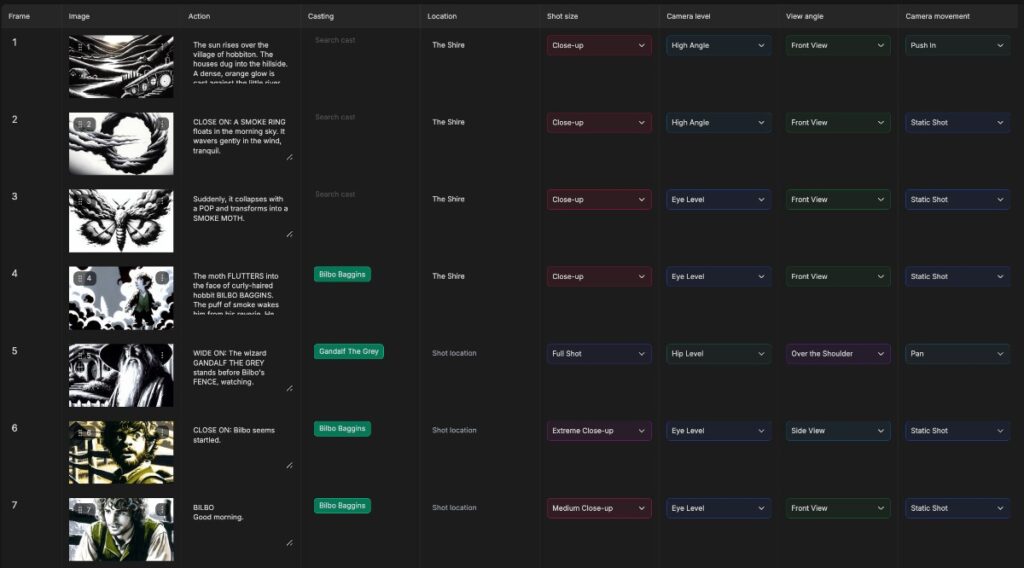
What is a shot list? 11 key components
As a filmmaker or producer, understanding and creating shot lists is crucial. A shot list is your film or video’s blueprint, detailing what each scene needs, like shot types, camera angles, and equipment. It’s a plan that transforms your script into a visual narrative.
Let’s break down the key components of a shot list and examples:
1. Scene Number and Description: Each shot is labeled with a scene number for easy reference. The description provides a brief overview of what happens in the scene.
For example, “Scene 12: The protagonist discovers a hidden door behind the bookshelf.”
2. Shot size: The type of shot is specified. The list of shot sizes is quite extensive, including close-ups, full shots, medium shots, etc. Shot size describes the proportion of the frame in relation to its contents. Essentially, it determines the extent of the subject or environment visible in each shot. The varied use of shot sizes after editing plays a key role in creating the rhythm and visual narrative of a scene.
For instance, “Shot 1: Full shot of the protagonist entering the room.”
3. Camera Angles and Movement: This includes details on how the camera should capture the scene. It could range from a static position to complex movements like tracking or panning.
For example: “Camera slowly pans as the protagonist searches the room.”
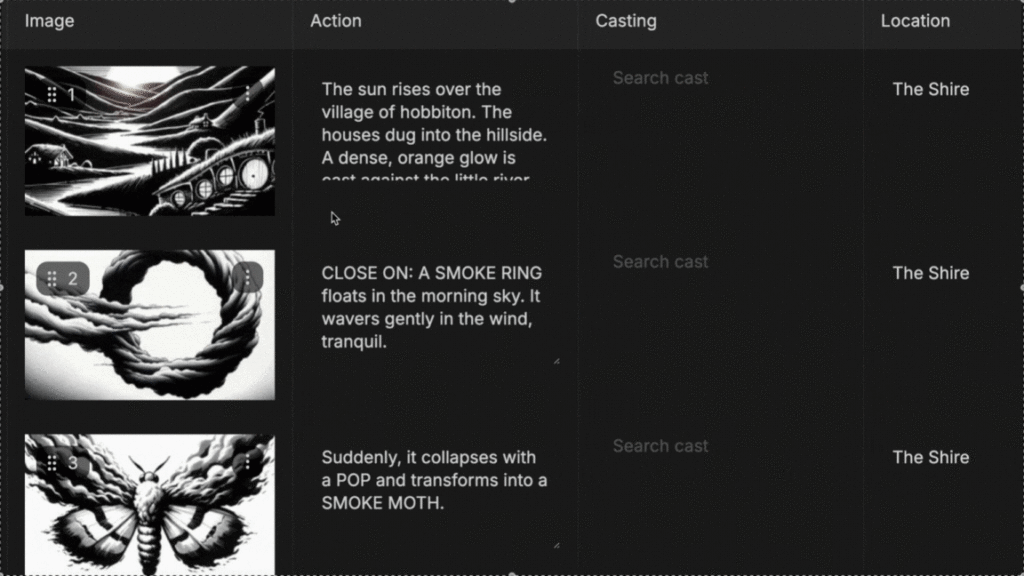
Example of someone using Shai’s shot list
4. Lens and Framing: Details about the camera lens and the framing of each shot.
For instance, “Use a 50mm lens for a tight frame on the protagonist’s face.”
5. Lighting and Color: Instructions for lighting setups and color schemes.
For example, “Low-key lighting to create a sense of mystery.”
6. Actor Placement and Movement: Directions for where actors should be positioned and how they should move.
For example, “The protagonist cautiously walks towards the bookshelf, looking over her shoulder.”
7. Dialogues: Specific dialogues to be spoken.
For instance, “Protagonist whispers, ‘What’s behind this door?’”
8. Props and Set Design: Any props needed for the shot and details about the set design.
For example: “A dusty, antique bookshelf filled with old books.”
9. Audio Requirements: Provide details on the audio aspect, including any off-screen sounds or music.
For example, “Sound of creaking floorboards as the protagonist walks.”
10. Special Effects or Visual Effects: If the shot requires any special or visual effects, it’s detailed here.
For example, “Visual effect of a glowing light emanating from behind the bookshelf.”
11. Duration: Estimated time or length of each shot.
For example, “This shot lasts for approximately 30 minutes.”
The importance of shot lists in different types of productions
Shot lists are vital across all filmmaking genres, including films, music videos, and documentaries. They serve as a roadmap, guiding the creative process and ensuring each production type is well-organized and focused.
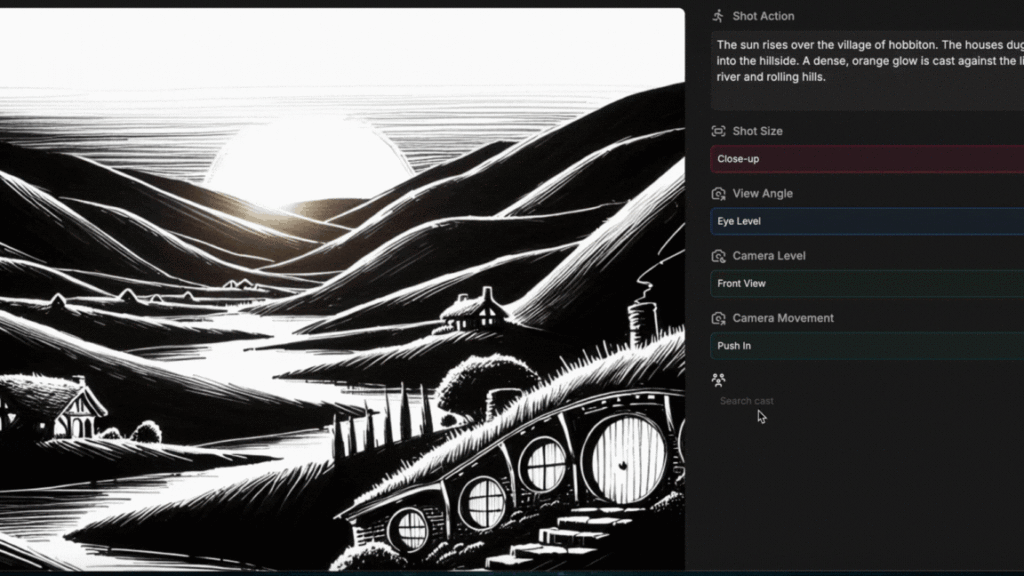
Example of someone creating a new image with Shai’s shot updates
Let’s look at why shot lists are important for each of the types of productions listed above:
Shot lists for films
- Narrative Clarity: Films often involve complex narratives. A shot list ensures each scene visually communicates the story effectively.
- Creative Consistency: Films require a consistent visual style. Shot lists help maintain this consistency across different scenes and shooting days.
- Resource Management: Films typically have substantial budgets. A detailed shot list helps manage resources efficiently, minimizing wasteful spending.
- Time Optimization: With tight shooting schedules, a shot list ensures that every minute on set is used productively, avoiding delays and confusion.
Shot lists for commercials
- Brand Messaging: Commercials are all about clear, concise brand messaging. Shot lists help focus each scene on delivering these messages effectively.
- Engagement: Commercials need to grab attention quickly. A shot list plans dynamic visuals that engage viewers right from the start.
- Efficiency: Commercial shoots are often time-constrained. A shot list aids in executing a large number of shots within a limited timeframe.
Shot lists for documentaries
- Realism and Authenticity: Documentaries aim to present real-life stories. Shot lists help plan out scenes to capture genuine moments while maintaining narrative flow.
- Flexibility: While documentaries require some degree of spontaneity, shot lists provide a structure to fall back on, ensuring key elements aren’t missed.
- Interview Planning: Interviews are a core component of documentaries. Shot lists ensure these are captured with the right tone and setting, enhancing the storytelling.
Shot lists for music videos
- Visual Storytelling: Music videos often tell a story or convey a theme alongside the music. Shot lists help in planning visually compelling sequences that complement the song.
- Artistic Expression: Music videos are a platform for artistic creativity. Shot lists allow directors to experiment with different styles and techniques in a structured way.
- Synchronization: Syncing visuals with music is vital. A shot list helps plan the shots according to the rhythm and beats of the music, ensuring a cohesive final product.
- Resourceful Shooting: Given the creative nature of music videos, shot lists help in maximizing the use of locations, props, and visual effects within budget constraints.
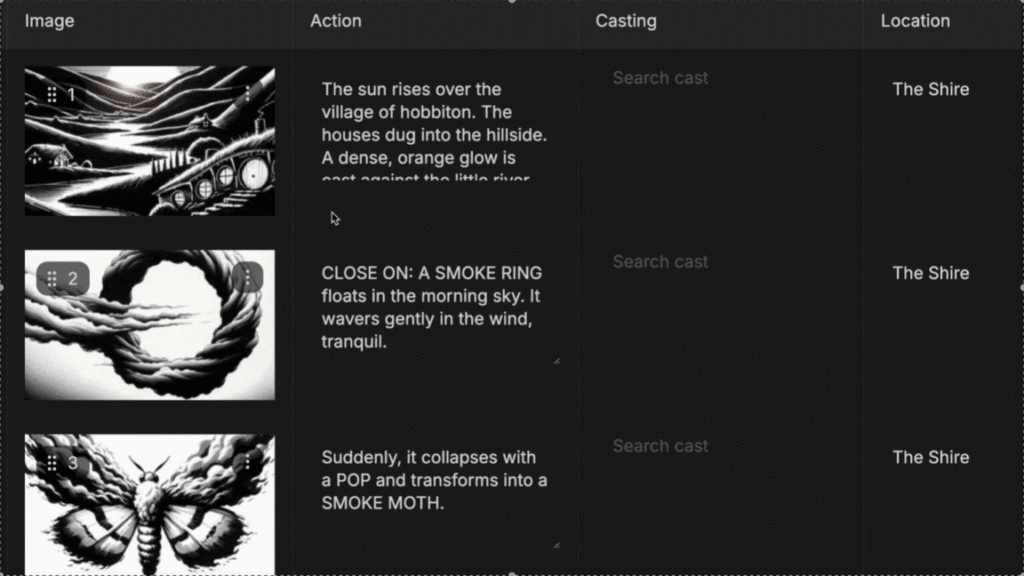
Example of someone making changes on Shai shot list
How to Create a Shot List: Step-By-Step
Creating a shot list is a collaborative process that involves detailing shots, camera placements, and other specifics, ensuring that every scene is thoroughly planned.
Let’s look at some details on who’s involved when creating a shot list.
- Director: The primary visionary behind the film, the director is deeply involved in the creation of the shot list. They decide the visual style and how each scene should look and feel.
- Cinematographer/Director of Photography (DoP): Working closely with the director, the cinematographer contributes expertise on camera angles, movements, and lighting to bring each shot to life.
- First Assistant Director (1st AD): They help in organizing and scheduling the shots as per the shot list, ensuring that the production stays on track.
- Other Contributors: Depending on the production scale, scriptwriters, producers, production designers, and even actors may provide input to the shot list for specific scenes.
5 Quick Steps on How to Make a Shot List
Now that the main roles involved in creating shot lists are defined let’s look at a high-level process of making a shot list.
1.Reading and Analysis of the Script: The process begins with a thorough reading of the script. The director and cinematographer identify key scenes and moments that require special attention.
2. Initial Discussion and Brainstorming: The director, cinematographer, and 1st AD discuss the vision for each scene, considering factors like narrative importance, emotional tone, and character development.
3. Detailing Each Shot: For every scene, the shot list is populated with the type of shot (e.g., wide, medium, close-up), camera movements (pan, tilt, dolly, etc.), camera angles (low angle, high angle, eye level), lighting requirements, actor placement and movement, any special effects or specific props needed.
4. Storyboard Creation: Sometimes, a storyboard is created alongside the shot list, providing visual sketches of each shot.
5. Revisions and Approvals: The shot list is reviewed and revised as needed, with the director’s final approval.
Pro Tip: Check out how to create a shot list for a more in-depth guide.
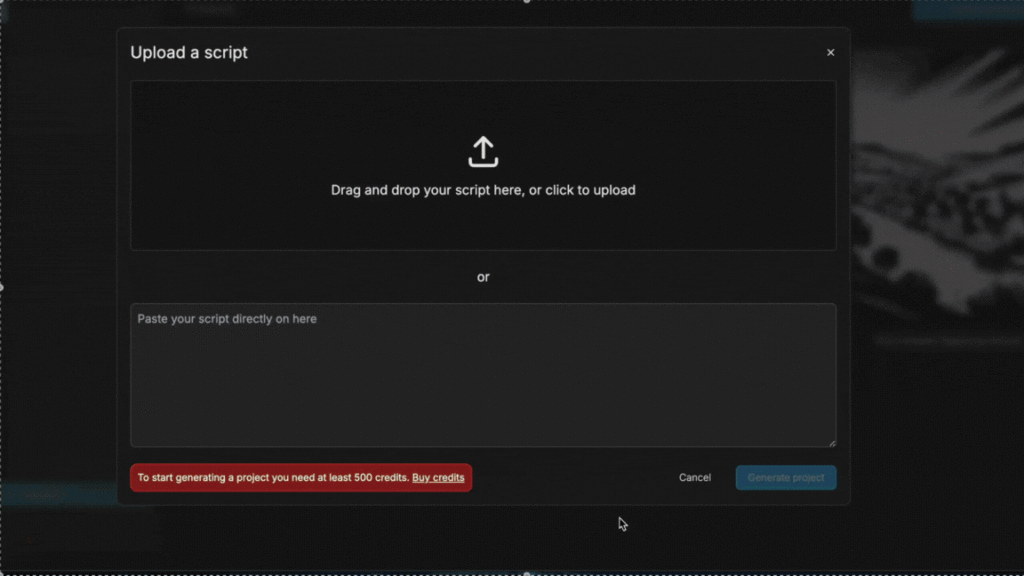
Example of someone turning a script into a shot list with Shai
The risks of not using a shot list
Skipping a shot list can lead to disorganization, forgotten shots, and budget issues. It’s like trying to build a house without any plans, which can lead to messy and unplanned results.
Let’s look at some specific risks of not having a well-prepared shot list.
Disorganization and confusion on set
Without a shot list, crew members may be unclear about the day’s plan. This can lead to confusion, with people unsure of what they should be doing or preparing for next.
Imagine a scene where the crew sets up for a close-up, only to realize later that the director wanted to start with a wide shot. This miscommunication can waste valuable time and disrupt the flow of work.
Missed or forgotten shots
A common risk of not having a shot list is missing crucial shots. This can lead to significant gaps in the storyline or key visual elements. In the early days of filmmaking, it wasn’t uncommon for directors to realize in the editing room that they missed a critical reaction shot or a cutaway, requiring expensive and time-consuming reshoots.
Inefficient use of time and resources
Without a clear plan, shooting can take much longer than necessary, leading to longer hours and increased costs. On a busy shooting day, if each setup takes longer to organize due to a lack of clear instructions, the production can quickly fall behind schedule, adding extra days of shooting and inflating the budget.
Compromised artistic vision
The director’s artistic vision might be compromised if scenes aren’t shot as planned or envisioned due to the lack of a shot list. For example, a director might envision a sequence of rapid shots to build tension but end up with longer, slower shots that don’t convey the desired intensity, affecting the overall impact of the scene.
Post-production challenges
Editing becomes more challenging without a shot list. The editor may struggle to piece together the story coherently, especially if key shots are missing. Editors have often faced difficulties in post-production when they receive footage that lacks continuity or misses narrative elements, leading to the use of suboptimal shots or even digital effects to fill the gaps.
Overextended budget
The lack of a shot list often leads to inefficiencies that can balloon the budget. Extra shooting days, additional crew hours, and potential reshoots all add up. Productions that have gone over budget due to disorganization and reshoots are a common tale in the industry. The famous reshoots for movies like “World War Z” and “Justice League” significantly increased their budgets because of a poorly planned pre-production.
Most Asked Questions
Below are some commonly asked questions relating to what a shot list is.
What’s the difference between a storyboard and a shot list?
Storyboards typically focus on visual storytelling, while shot lists are more detailed and include technicalities like lighting, camera angles, camera movements, and other shooting specifics.
Who makes the shot list?
As mentioned, a shot list is created by the director, cinematographer, and the first assistant director.
Do I need a shot list if I have a storyboard?
Yes. Shot lists go hand in hand with other pre-production processes, such as scriptwriting and storyboarding. They’re a “shooting schedule” that helps you organize and prepare for filming without missing anything.
Shot list definition & more | Wrapped up
In conclusion, creating a shot list is not just a step in the filmmaking process but an essential component that sets the vision and execution of a project.
Whether it’s a grand cinematic piece, an impactful commercial, a deep-diving documentary, or a music video, a shot list serves as the backbone of the pre-production process, ensuring that every element, from the narrative to the smallest visual detail, is thoughtfully planned and realized.
The risks of not going through this crucial pre-production step are substantial, potentially leading to disorganized shoots, missed opportunities, and even overextended budgets.
On the other hand, a well-executed shot list can transform a good film into a great one, ensuring that every scene contributes powerfully to the overarching narrative and visual impact.
That said, creating shot lists can be a tedious and long process, often using a lot of time and resources. This is where Shai’s AI shot list generator can make your pre-production process 100 times faster, more affordable, and creative.